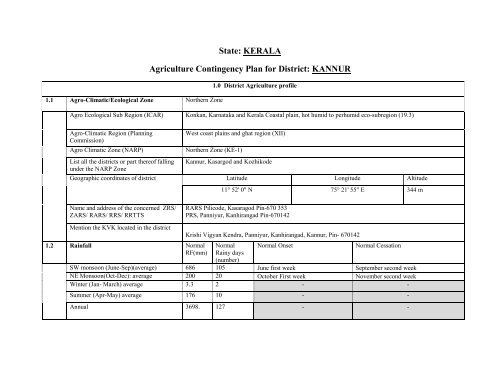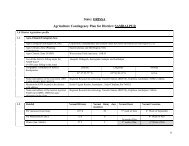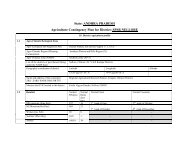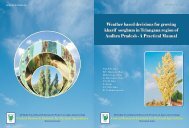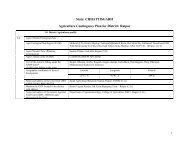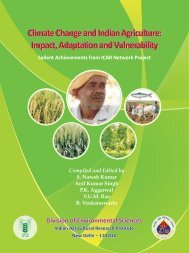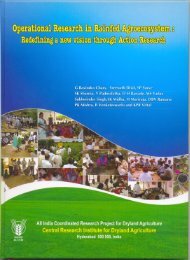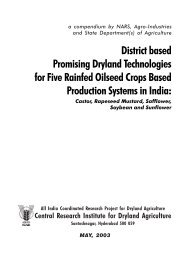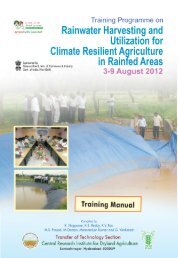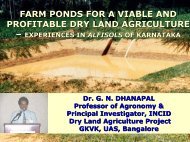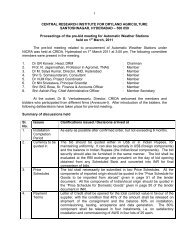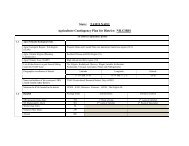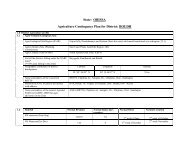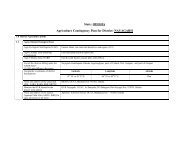You also want an ePaper? Increase the reach of your titles
YUMPU automatically turns print PDFs into web optimized ePapers that Google loves.
1.1 Agro-Climatic/Ecological Zone Northern Zone<br />
State: KERALA<br />
Agriculture Contingency Plan for District: <strong>KANNUR</strong><br />
1.0 District Agriculture profile<br />
Agro Ecological Sub Region (ICAR) Konkan, Karnataka and Kerala Coastal plain, hot humid to perhumid eco-subregion (19.3)<br />
Agro-Climatic Region (Planning<br />
Commission)<br />
West coast plains and ghat region (XII)<br />
Agro Climatic Zone (NARP) Northern Zone (KE-1)<br />
List all the districts or part thereof falling<br />
under the NARP Zone<br />
Kannur, Kasargod and Kozhikode<br />
Geographic coordinates of district Latitude Longitude Altitude<br />
Name and address of the concerned ZRS/<br />
ZARS/ RARS/ RRS/ RRTTS<br />
Mention the KVK located in the district<br />
1.2 Rainfall Normal<br />
RF(mm)<br />
11° 52' 0" N 75° 21' 55" E 344 m<br />
RARS Pilicode, Kasaragod Pin-670 353<br />
PRS, Panniyur, Kanhirangad Pin-670142<br />
Krishi Vigyan Kendra, Panniyur, Kanhirangad, Kannur, Pin- 670142<br />
Normal<br />
Rainy days<br />
(number)<br />
Normal Onset<br />
Normal Cessation<br />
SW monsoon (June-Sep)(average) 686 105 June first week September second week<br />
NE Monsoon(Oct-Dec): average 200 20 October First week November second week<br />
Winter (Jan- March) average 3.3 2 - -<br />
Summer (Apr-May) average 176 10 - -<br />
Annual 3698.<br />
127 - -
1.3 Land use<br />
pattern of the<br />
district (latest<br />
statistics)<br />
Area (‘000 ha)<br />
Geographical<br />
Area<br />
(‘000 HA)<br />
1. 4 Major Soils (common names like shallow<br />
red soils etc.,)<br />
Forest area<br />
(‘000 ha)<br />
Land under<br />
non-<br />
agricultural use<br />
Permanent<br />
pastures<br />
Cultivable<br />
wasteland<br />
Land under<br />
Misc. tree<br />
crops and<br />
groves<br />
Barren and<br />
uncultivable<br />
land<br />
296.6 18.9 21.7 0.011 4.6 1.1 9.9 3.5<br />
Area (‘000 ha) Percent (%) of total<br />
1. Red Laterite soils 217.7 75<br />
2. Alluvial Soil 8.9 2<br />
3. forest soil 18.9 7<br />
4. Hydromorpic saline 11.7 6<br />
5. Riverine alluvium 32.9 10<br />
Others (specify):<br />
1.5 Agricultural land use Area (‘000 ha) Cropping intensity %<br />
Net sown area 228.9<br />
Area sown more than once 10.1<br />
Gross cropped area 247.0<br />
1.6 Irrigation Area (‘000 ha)<br />
108<br />
Current<br />
fallows<br />
Net irrigated area 49.5<br />
Gross irrigated area 19.9<br />
Rainfed area 199.6<br />
Sources of Irrigation Number Area (‘000 ha) Percentage of total irrigated area<br />
Canals 1.3 6.6<br />
Tanks - 1.7 8.9<br />
Open wells - 8.3 41.8<br />
Other<br />
fallows<br />
2
Bore wells - 5.0 0.01<br />
Lift irrigation - 0.2 1.2<br />
Micro-irrigation 0.7 3.5<br />
Other sources - 7.4 37.0<br />
Total Irrigated Area 24.6<br />
Pump sets 295.9<br />
No. of Tractors 60<br />
Groundwater availability and use* (Data No. of blocks/ (%) area<br />
source: State/Central Ground water<br />
Department /Board)<br />
Tehsils<br />
Over exploited -<br />
Critical -<br />
Semi- critical -<br />
Safe -<br />
Wastewater availability and use -<br />
Ground water quality<br />
*over-exploited: groundwater utilization > 100%; critical: 90-100%; semi-critical: 70-90%; safe:
Banana - - - - 5.4<br />
Horticulture crops -<br />
Fruits<br />
Total area<br />
Jack -<br />
Mango 12.0<br />
Banana -<br />
Plantain 3.5<br />
Pineapple 0.27<br />
Horticultural crops -<br />
Vegetables<br />
Total area<br />
Turmeric 0.15<br />
ginger 0.15<br />
tapoica 2.60<br />
Food crops 115.7<br />
Bitterguard -<br />
Medicinal and Aromatic<br />
crops<br />
Total area<br />
Nil Nil<br />
Sesamum 1<br />
Plantation crops Total area<br />
Rubber 62.11<br />
Cashew 42.0<br />
coco 0.18<br />
Fodder crops Total area<br />
Fodder grass -<br />
Total fodder crop area<br />
Grazing land<br />
Sericulture etc<br />
4
1.8 Livestock Male (‘000) Female (‘000) Total (‘000)<br />
Non descriptive Cattle (local low yielding) - 22.0 22.0<br />
Crossbred cattle - 112.7 112.7<br />
Non descriptive Buffaloes (local low yielding) - 0.995 0.995<br />
Graded Buffaloes<br />
Goat 90.17<br />
Sheep 0.664<br />
Others (Camel, Pig, Yak etc.) 0.259<br />
Commercial dairy farms (Number)<br />
1.9 Poultry No. of farms Total No. of birds (‘000)<br />
Commercial 151.764<br />
Backyard 23.701<br />
1.10 Fisheries (Data source: Chief Planning Officer)<br />
A. Capture<br />
i) Marine (Data Source:<br />
Fisheries Department)<br />
ii) Inland (Data Source:<br />
Fisheries Department)<br />
B. Culture<br />
i) Brackish water (Data Source:<br />
MPEDA/ Fisheries Department)<br />
No. of fishermen Boats Nets Storage facilities<br />
(Ice plants etc.)<br />
Mechanized Non- Mechanized Non-mechanized<br />
mechanized (Trawl nets, (Shore Seines,<br />
Gill nets) Stake & trap nets)<br />
Marine: 6024<br />
Inland: 1813<br />
273 169 T Net-128<br />
G Net- 11<br />
Shore Seine-32<br />
Stake Net-577<br />
No. Farmer owned ponds No. of Reservoirs No. of village tanks<br />
1500 1200<br />
Water Spread Area (ha)<br />
Yield (t/ha) Production (‘000 tons)<br />
300 0.7 t/ha 210<br />
18<br />
5
ii) Fresh water (Data Source: Fisheries<br />
Department)<br />
Others<br />
1.11 Production and Productivity of major crops (Average of last 5 years: 2004, 05, 06, 07, 08)<br />
1.11 Name of crop Kharif<br />
Production<br />
('000 t)<br />
Productivity<br />
(kg/ha)<br />
Production<br />
('000 t)<br />
Major Field crops (Crops to be identified based on total acreage)<br />
80 3.0 t/ha 240<br />
Rabi Summer<br />
Productivity<br />
(kg/ha)<br />
Production<br />
('000 t)<br />
Productivity<br />
(kg/ha)<br />
Production<br />
('000 t)<br />
Total Crop<br />
Productivity<br />
(kg/ha)<br />
Paddy 20.8 1.7<br />
Ginger 0.5 3.1<br />
Coconut 0.6 6.2<br />
Coco 0.08 0.35<br />
Pepper 1.5 0.24 4.7 0.18<br />
Cashew 0.92<br />
Major Horticultural crops (Crops to be identified based on total acreage)<br />
Banana 2.0 4.0 5.0 7.0 0.70 0.25 2.29 8.86<br />
Coconut 0.44 7.8 0.64 6.26<br />
Plantain 12.2 5.8 16.22 4.74<br />
Pineapple 1.60<br />
Pappaya<br />
Mango 88.88<br />
Arecanut 14.74<br />
residue as<br />
fodder<br />
(‘000<br />
tons)<br />
6
1.12 Sowing window for 5 major<br />
field crops<br />
(start and end of normal sowing<br />
period)<br />
Paddy Coconut Arecanut Vegetable<br />
Kharif- Rainfed June 1 st -Sept.30 June 1 st -Sept.30 June 1 st - Nov.30 June 1 st -Sept.30<br />
Kharif-Irrigated - - - -<br />
Rabi- Rainfed Oct.- Jan.30 - - Oct.- Jan.30<br />
Rabi-Irrigated - - - -<br />
1.13 What is the major contingency the<br />
district is prone to? (Tick mark and<br />
mention years if known during the last 10<br />
year period)<br />
Drought<br />
Flood<br />
Cyclone<br />
Hail storm<br />
Heat wave<br />
Cold wave<br />
Frost<br />
Sea water intrusion<br />
Regular<br />
Pests and diseases (specify)<br />
BPH, Leaf roller, Mite, Bud rot, Mahali √<br />
√<br />
√<br />
Occasional None<br />
√<br />
√<br />
7
1.14 Include Digital maps of<br />
the district for<br />
2.0 Strategies for weather related contingencies<br />
2.1 Drought<br />
2.1.1 Rainfed situation<br />
Location map of district within State as Annexure I<br />
Enclosed: No<br />
Mean annual rainfall as Annexure 2 Enclosed: No<br />
Soil map as Annexure 3 Enclosed: No<br />
Condition Suggested Contingency measures<br />
Early season<br />
drought<br />
(delayed<br />
onset)<br />
Delay by 2<br />
weeks<br />
(June 3 rd<br />
Week)<br />
Major<br />
Farming<br />
situation<br />
Sandy clay<br />
loam<br />
Clay loam<br />
Sandy loam<br />
Normal<br />
Crop/cropping<br />
system<br />
Rice-Rice<br />
Rice-Vegetables<br />
Rice -Pulse<br />
Arecanut + Pepper<br />
Coconut + Pepper<br />
Rice -Pulse<br />
Coconut + Banana<br />
Arecanut + Banana +<br />
Pepper<br />
Coconut + Pepper<br />
Change in<br />
crop/cropping<br />
system<br />
Rice-Rice<br />
Rice-Vegetables<br />
Rice -pulse<br />
Agronomic measures Remarks on Implementation<br />
• Direct seeding for the first<br />
crop<br />
• Prefer short duration varieties<br />
• Prepare mat nursery and adopt<br />
community nursery<br />
• Adopt closer spacing and<br />
increase the number of<br />
seedlings to 3-4 numbers/hill<br />
and give additional N @5<br />
kg/ha<br />
• Spray of B and K increases<br />
drought tolerance.<br />
• Apply silica<br />
• Mulching<br />
• organic manuring<br />
• Sprinkler Irrigation/micro<br />
irrigation/supplemental<br />
irrigation.<br />
Capacity building of padasekhara<br />
samithy.<br />
Micro Irrigation Scheme and<br />
RKVY<br />
SHM<br />
8
Condition<br />
Early season<br />
drought<br />
(delayed<br />
onset)<br />
Delay by 4<br />
weeks<br />
(July first<br />
Week)<br />
Condition<br />
Early season<br />
drought<br />
(delayed<br />
onset)<br />
Delay by<br />
6weeks<br />
(July third<br />
Week)<br />
Major<br />
Farming<br />
situation<br />
Sandy clay<br />
loam<br />
Clay loam<br />
Sandy loam<br />
soils<br />
Major<br />
Farming<br />
situation<br />
Sandy clay<br />
loam<br />
Clay loam<br />
Sandy loam<br />
Normal<br />
Crop/cropping<br />
system<br />
Rice-Rice<br />
Rice-Vegetables<br />
Rice -Pulse<br />
Arecanut + Pepper<br />
Coconut + Pepper<br />
Rice -Pulse<br />
Coconut + Banana<br />
Arecanut + Banana +<br />
Pepper<br />
Coconut + Pepper<br />
Normal<br />
Crop/cropping<br />
system<br />
Change in<br />
crop/cropping<br />
system<br />
Rice-Rice<br />
Rice-Vegetables<br />
Rice -pulse<br />
Change in<br />
crop/cropping<br />
system<br />
Suggested Contingency measures<br />
Agronomic measures<br />
• Direct seeding for the first crop<br />
• Prefer short duration varieties<br />
• Prepare mat nursery and adopt community<br />
nursery<br />
• Adopt closer spacing and increase the number<br />
of seedlings to 3-4 numbers/hill and give<br />
additional N @5 kg/ha<br />
• Spray of B and K increases drought tolerance<br />
• Apply silica mulching<br />
• organic manuring<br />
• Sprinkler Irrigation/micro<br />
irrigation/supplemental irrigation.<br />
• Wet seeding of short duration varieties<br />
• Adopt single crop of long duration variety<br />
Suggested Contingency measures<br />
Agronomic measures<br />
Not Applicable<br />
Remarks on<br />
Implementation<br />
Capacity building of<br />
padasekhara samithy.<br />
Micro Irrigation<br />
Scheme and RKVY<br />
SHM<br />
Remarks on<br />
Implementation<br />
9
Condition<br />
Early season<br />
drought (delayed<br />
onset)<br />
Delay by 8 weeks<br />
(August first<br />
Week)<br />
Major Farming<br />
situation<br />
Sandy clay loam<br />
Clay loam<br />
Sandy loam soils<br />
Normal<br />
Crop/cropping<br />
system<br />
Change in<br />
crop/cropping<br />
system<br />
Suggested Contingency measures<br />
Agronomic measures<br />
Not Applicable<br />
Condition Suggested Contingency measures<br />
Early season drought<br />
(Normal onset)<br />
Normal onset<br />
followed by 15-20<br />
days dry spell after<br />
sowing leading to<br />
poor<br />
germination/crop<br />
stand etc.<br />
Major<br />
Farming<br />
situation<br />
Sandy clay<br />
loam<br />
Clay loam<br />
Sandy loam<br />
soils<br />
Normal<br />
Crop/cropping<br />
system<br />
Rice-Rice<br />
Rice-Vegetables<br />
Rice -pulse<br />
Crop management<br />
• If transplanting is delayed, adopt closer<br />
spacing, increase the number of seedlings to<br />
3-4 numbers/hill and give additional N<br />
@5Kg/ha<br />
• Practice appropriate seed hardening<br />
techniques.<br />
• Under semidry situation, wherein sowing is<br />
already over, practice thinning of crop stand,<br />
reduce plant population and use the biomass<br />
as mulch and do interculture using dry land<br />
weeder.<br />
• Life saving irrigation with available water.<br />
• Supply the fertilizer nutrients through foliar<br />
application<br />
• Seed treatment with micronutrients.<br />
Soil nutrient<br />
& moisture<br />
conservation<br />
measures<br />
Application of<br />
P and K as<br />
basal, Reduce<br />
N dose, Apply<br />
bulky organic<br />
manures.<br />
Application<br />
of soil<br />
ameliorants .<br />
Remarks on<br />
Implementation<br />
Remarks on<br />
Implementation<br />
Capacity building of<br />
padasekhara samithy.<br />
RKVY<br />
SHM<br />
10
Condition Suggested Contingency measures<br />
Mid season<br />
drought (long dry<br />
spell, consecutive 2<br />
weeks rainless<br />
(>2.5 mm) period)<br />
At vegetative stage<br />
Major Farming<br />
situation<br />
Sandy clay loam<br />
Clay loam<br />
Sandy loam<br />
Normal<br />
Crop/cropping<br />
system<br />
Rice-Rice<br />
Rice-Vegetables<br />
Rice- Sesamum<br />
Pepper +<br />
arecanut<br />
Crop management<br />
• Suppresses weed growth, Make<br />
Shelterbelts, spraying potassium<br />
chloride, thinning of 33–50%<br />
population anti-transpirant spray.<br />
mulching<br />
• Suppresses weed growth,<br />
• Make Shelterbelts Establishment of<br />
leguminous cover crop,<br />
• Shading the young plants, white<br />
washing the main stem,<br />
• Antitranspirant spray<br />
Soil nutrient & moisture<br />
conservation measure<br />
• Irrigate at 1 to 4 days after<br />
disappearance of ponded<br />
water,<br />
• Insitu rainwater conservation,<br />
• Application of P and K as<br />
basal,<br />
• Reduce N dose,<br />
• Apply bulky organic<br />
manures.<br />
• Collection and conservation<br />
of rain water,<br />
• Intermittent flooding,<br />
maintaining the soil in subsaturated<br />
condition,<br />
• Alternate drying and wetting.<br />
• Zero tillage,<br />
• Mulching,<br />
• Sub-surface storing of<br />
ground water,<br />
• Less exploitation of ground<br />
water,<br />
• Drip irrigation,<br />
• Terracing,<br />
• Husk burial,<br />
• leaf cutting.<br />
Remarks on<br />
Implementati<br />
on<br />
11
At flowering/<br />
fruiting stage<br />
Sandy clay loam<br />
Clay loam<br />
Sandy loam<br />
Terminal drought Sandy clay loam<br />
Clay loam<br />
Sandy loam<br />
Rice-Rice<br />
Rice-Vegetables<br />
Rice- Sesamum<br />
Pepper +<br />
arecanut<br />
Rice-Rice<br />
Rice-Vegetables<br />
Rice- Sesamum<br />
Pepper +<br />
arecanut<br />
Formation of Shelterbelts. Antitranspirant<br />
spray<br />
• Sprinkler irrigation (especially<br />
for pepper),<br />
• Suppresses weed growth,<br />
• Formation of Shelterbelts,<br />
Antitranspirant spray<br />
• Terminate the irrigation<br />
14 to 17 days before harvest,<br />
• Harvesting at physiological<br />
maturity,<br />
• Establishment of leguminous<br />
cover crop,<br />
• Shading,<br />
• Pruning of coffee,<br />
• Antitranspirant spray<br />
• Irrigate at 1 to 4 days after<br />
disappearance of ponded<br />
water,<br />
• Insitu rainwater conservation,<br />
• Collection and conservation<br />
of rain water,<br />
• Intermittent flooding,<br />
• maintaining the soil in subsaturated<br />
condition,<br />
• alternate drying and wetting.<br />
• Mulching,<br />
• Sub-surface storing of ground<br />
water,<br />
• Less exploitation of ground<br />
water,<br />
• Drip irrigation,<br />
• Terracing,<br />
• Maintaining the soil in subsaturated<br />
condition,<br />
• Alternate drying and wetting.<br />
• Sub-surface storing of ground<br />
water,<br />
• Less exploitation of ground<br />
water,<br />
• Drip irrigation,<br />
• Terracing,<br />
• Husk burial,<br />
• Leaf cutting.<br />
12
2.1.2 Irrigated situation<br />
Condition<br />
Delayed release of<br />
water in canals<br />
due to low rainfall<br />
Condition<br />
Limited release of<br />
water in canals<br />
due to low rainfall<br />
Condition<br />
Non release of<br />
water in canals<br />
under delayed<br />
Major Farming<br />
situation<br />
Sandy clay loam<br />
Clay loam<br />
Sandy loam<br />
Major Farming<br />
situation<br />
Sandy clay loam<br />
Clay loam<br />
Sandy loam<br />
Major Farming<br />
situation<br />
Sandy clay loam<br />
Clay loam<br />
Sandy loam<br />
Suggested Contingency measures<br />
Normal Crop/cropping<br />
system<br />
Change in crop/cropping<br />
system<br />
Agronomic measures<br />
Remarks on<br />
Implementation<br />
Rice-Rice Rice (SD)-Rice (SD) • Mulching, NREGS<br />
Seed village program<br />
• Strip cropping, for SD varieties.<br />
Rice-Vegetables Rice(SD)-Vegetables<br />
Normal Crop/cropping<br />
system<br />
Rice-Rice<br />
Rice-Vegetables<br />
Normal Crop/cropping<br />
system<br />
• Selection of<br />
suitable cropping<br />
systems<br />
Suggested Contingency measures<br />
Change in crop/cropping<br />
system<br />
Agronomic measures<br />
Remarks on<br />
Implementation<br />
NREGS,<br />
Rice (SD)-Rice<br />
• Mulching,<br />
• Strip cropping,<br />
RKVY Seed village<br />
program for SD<br />
• Selection of suitable varieties. Capacity<br />
cropping systems, building of<br />
• Reduce the area padasekhara samithy.<br />
Rice(SD)-Pulses<br />
under cultivation,<br />
• Increase spacing<br />
Suggested Contingency measures<br />
Change in crop/cropping<br />
Agronomic measures<br />
system<br />
Rice-Rice Rice (single crop)/Pulses<br />
• Rain water<br />
harvesting,<br />
• Direct sowing,<br />
Remarks on<br />
Implementation<br />
NREGS,<br />
RKVY<br />
13
Condition<br />
Major Farming<br />
situation<br />
Normal Crop/cropping<br />
system<br />
onset of monsoon<br />
in catchment Rice-Vegetables<br />
Suggested Contingency measures<br />
Change in crop/cropping<br />
Agronomic measures<br />
system<br />
• Delayed sowing<br />
Suggested Contingency measures<br />
Condition Major Farming<br />
situation<br />
Normal Crop/cropping<br />
system<br />
Change in crop/cropping<br />
system<br />
Agronomic measures<br />
Insufficient Sandy clay loam Rice-Rice Rice-Rice • Check dams,<br />
groundwater<br />
recharge due to<br />
low rainfall<br />
Clay loam<br />
Sandy loam<br />
Rice-Vegetables Rice-Vegetables<br />
• Percolation pits,<br />
• Rain water<br />
harvesting,<br />
• Water conservation<br />
measures<br />
2.2 Unusual rains (untimely, unseasonal etc) (for both rainfed and irrigated situations)<br />
Condition Suggested contingency measure<br />
Continuous high rainfall in a<br />
short span leading to water<br />
logging<br />
Rice Improve drainage<br />
facility<br />
Horticulture<br />
Coconut<br />
Pepper<br />
Vegetative stage Flowering stage Crop maturity stage Post harvest<br />
Improve drainage<br />
facility<br />
• Improve drainage<br />
facility,<br />
• Cultivation of<br />
varieties having seed<br />
dormancy,<br />
• Harvest the crop at<br />
physiological<br />
maturity.<br />
Improve drainage facility, Cover crops, Strip cropping with fodder<br />
grasses, Collection and conservation of rainwater.<br />
Remarks on<br />
Implementation<br />
Remarks on<br />
Implementation<br />
NREGS,<br />
RKVY<br />
Improve storage facility/godowns<br />
Improve storage facility/godowns<br />
14
Banana<br />
Arecanut<br />
Heavy rainfall with high speed<br />
winds in a short span<br />
Rice Shelter belts, alley cropping, Improve drainage facility Improve storage facility/godowns<br />
Horticulture<br />
Coconut<br />
Pepper<br />
Banana<br />
Arecanut<br />
Propping of banana plants, Improve drainage facility, shelter belts,<br />
lopping of pepper standards<br />
Condition Suggested contingency measure<br />
Outbreak of pests and diseases due to<br />
unseasonal rains<br />
Rice Cultivation of resistant varieties,<br />
Application of bio-control agents, Use of<br />
disease free seeds, Proper seed treatment<br />
with biocontrol agents, Balanced application<br />
of fertilizers, Phyto-sanitation<br />
Horticulture<br />
Improve storage facility/godowns<br />
Vegetative stage Flowering stage Crop maturity stage Post harvest<br />
Harvest the crop at<br />
physiological maturity.<br />
Coconut<br />
Crown clearing to control the fungus. Provide proper drainage and spray 1<br />
% BM before the onset of monsoon. Apply soil ameliorants and adopt soil<br />
test based nutrient management.<br />
Pepper Remove and burn all infected plant debris and dead vines along with root<br />
system to reduce the build up of the inoculum in the field. Prune the runner<br />
shoots or tie back to vines before the onset of monsoon. Prune off the<br />
leaves and shoots of vines to a height of 2 feet from the soil. Application of<br />
bio-control agents. Apply soil ameliorants and adopt soil test based nutrient<br />
Improve storage facility<br />
15
Banana<br />
Arecanut<br />
2.3 Floods<br />
management.<br />
Remove and destroy severely infected and completely dried leaves, Use<br />
disease free healthy planting material. Avoid any sort of root injury through<br />
intercultural operations or by nematode infestation, Provide better drainage,<br />
Apply soil ameliorants and adopt soil test based nutrient management.<br />
Grow cover crops in the garden and apply in situ. Avoid water stagnation in<br />
the garden by providing drainage facilities. Prophylactic spray of 1%<br />
Bordeaux mixture with stickers once before the onset of south west<br />
monsoon followed by second and third applications at 40-45 days interval.<br />
Collect and destroy all fallen and infected nuts. Apply soil ameliorants and<br />
adopt soil test based nutrient management.<br />
Condition Suggested contingency measure<br />
Transient water logging/ partial<br />
inundation<br />
Seedling / nursery stage Vegetative stage Reproductive stage At harvest<br />
Harvest the crop at<br />
Rice<br />
River embankments, Improve drainage facility, scientific and proper land utilization,<br />
cultivation flood tolerant varieties, Crop insurance<br />
physiological maturity,<br />
Cultivation of varieties<br />
having seed dormancy<br />
Horticulture<br />
Coconut.<br />
Pepper<br />
Banana<br />
Arecanut<br />
Continuous submergence<br />
for more than 2 days<br />
Rice<br />
Horticulture<br />
Timely cleaning, de-silting and deepening of natural water reservoir and drainage channels, Construction and protection of<br />
all the flood protection embankments, ring bunds and other bunds. Dams and levees can also be constructed which can be<br />
used as temporarily storing space which reduces the chances of lower plains getting flooded.<br />
Cultivation flood tolerant varieties(especially used in deep water rice cultivation) Crop insurance Improve drainage<br />
facility,<br />
Coffee Timely cleaning, de-silting and deepening of natural water reservoir and drainage channels, Construction and protection of<br />
16
Pepper<br />
Banana<br />
Arecanut<br />
2.4 Extreme events: Heat wave / Cold wave/Frost/ Hailstorm /Cyclone<br />
Condition Suggested contingency measures<br />
Heatwave NA<br />
Coldwave NA<br />
Frost NA<br />
Hailstorm NA<br />
Cyclone NA<br />
2.5 Contingent strategies for Livestock, Poultry<br />
2.5.1 Livestock<br />
DROUGHT<br />
LIVESTOCK<br />
all the flood protection embankments, ring bunds and other bunds. Dams and levees can also be constructed which can be<br />
used as temporarily storing space which reduces the chances of lower plains getting flooded.<br />
BEFORE THE EVENT DURING THE EVENT AFTER THE<br />
EVENT<br />
1. Cultivation of drought resistant fodder varieties like<br />
Andropogon and Guinea grass in the fodder plots<br />
2. Preservation of fodder available as silage or hay for<br />
feeding during the drought<br />
3. Identification of tree fodders in the locality which<br />
can be utilized for drought season<br />
4. Identification of unconventional feed and fodder<br />
resources in the locality which can be used in the<br />
1. Feeding straw, hay and silage and at least one third of<br />
green fodder<br />
2. Feeding available tree fodders and other unconventional<br />
feed stuffs.<br />
3. Restrict grazing of animals to cool hours of the day<br />
4. Provide clean, cool drinking water adlibitum or at least<br />
four times daily.<br />
5. Improve the ventilation of existing animal sheds<br />
6. Spraying of water to large animals during hot hours of<br />
the day<br />
7. Spreading insulatory materials over the roof of the<br />
animal sheds<br />
8. Provide most of the feed and fodder during the cool<br />
1. Flushing of all<br />
the stock<br />
2. Gradual switch<br />
over to normal<br />
diet<br />
17
Health and<br />
disease<br />
management<br />
drought<br />
5. Cultivating cereal fodder like maize and sorghum in<br />
the now available irrigated tract and preserving it as<br />
silage for the drought.<br />
6. Identification of fallow wet lands in the area and to<br />
go for grass cultivation as to get fodder even during<br />
the drought with existing moisture in the soil.<br />
7. Conservation and storage of water in rain<br />
harvesting facilities for the drought season.<br />
Vaccination of animals Planting of trees should be<br />
done around the shed<br />
hours of the day.<br />
9. Use the waste water from the sheds for irrigating the<br />
fodder plots<br />
10. Use the stored water for cooling the animal and washing<br />
and restrict the use of good potable water for drinking.<br />
Shed should be clean. Allow cool air to flow inside shed. Proper<br />
ventilation of shed.<br />
Heat wave and cold wave When heat wave is more cold water spraying. When cold wave is more light full covering of shed.<br />
Shelter/environment management Construction of sheds with proper<br />
ventilation. Planting trees around<br />
sheds.<br />
Health and disease management Vaccination providing adequate feed<br />
for animals<br />
Construction of<br />
sheds with proper<br />
ventilation-<br />
cleaning of shed<br />
everyday.<br />
And feed additives can be given Dung should be removed from pits.<br />
Cleaning of surroundings.<br />
Mineral mixture and feed additives<br />
can be given<br />
Proper feeding of animals<br />
18
2.5.2 Poultry<br />
Drought – poultry<br />
Before the event During the event After the event<br />
1. Preventive vaccinations against<br />
Raniket disease, Fowl pox and<br />
infectious bronchitis<br />
2. Deworming of all the birds<br />
Storage of feed ingredients Storing of feed and ingredients<br />
1. Provide clean cool drinking water at all<br />
times adlibitum<br />
2. Addition of anti-stress agents and<br />
antioxidants in the feed<br />
3. Protection from direct sunlight by<br />
curtains on the sides of sheds and<br />
otherwise ensuring maximum ventilation<br />
4. Insulating material spread over roof<br />
5. Supplementation of minerals and<br />
vitamins in the feed<br />
Provide kitchen waste and feed additives<br />
vitamin mineral mixtures<br />
Drinking water Storage of clean drinking water Provide cold clean water<br />
Health and disease management Vaccination of birds<br />
Floods<br />
Medicated water and Balanced feed should<br />
be given<br />
Cultivation of maize and other feed<br />
ingredients<br />
Digging of bore wells for drinking<br />
water<br />
Provide clean coops for shelter<br />
Storage of feed ingredients Storing of feed and ingredients Provide balanced feed Cultivation of maize and fodder<br />
Drinking water Storage of clean drinking water Provide clean water Construction of tanks and wells<br />
Health and disease management Vaccination of birds<br />
Cyclone<br />
Provide medicated water and feed<br />
additives<br />
Storage of feed ingredients Storing of feed and ingredients Provide feed and clean water<br />
Provide clean coops for shelter<br />
Cultivation of maize and other<br />
fodder<br />
Drinking water Storage of water Provide clean feed and water Construction of wells<br />
19
Health and disease management Vaccination of birds Medicated water and feed additives Provide clean shelter<br />
Heat wave and cold wave<br />
Shelter/environment<br />
management<br />
Health and disease management<br />
Floods<br />
Planting of trees around shed.<br />
Exhaust fan should be fitted on the<br />
hoof.<br />
Vaccination of birds. Provide water<br />
and feed<br />
Feed and fodder availability Storage of feed and fodder in air tight<br />
containers fungal attack.<br />
Put gunny bags dipped water in the direction<br />
of wind.<br />
Close the door and ventilation when cold<br />
wind comes, during day and night<br />
Provide proper ventilation<br />
Provide clean coops and balanced<br />
feed<br />
Feeding good quality feed and fodder with Feed and fodder - dry in sunlight<br />
Drinking water Storage of clean drinking water Provide hot water for drinking Storage of clean water - digging of<br />
wells.<br />
Health and disease management Provide balanced feed and<br />
vaccination of animals at proper time.<br />
Provide dry atmosphere for the sheds. Mineral mixture feed additives<br />
should be given.<br />
Cyclone .<br />
Feed and fodder availability Storage of feed and fodder Use the conserved fodder. Provide balanced feed and fodder<br />
Drinking water Storage of water Provide clean water for drinking Construction of tanks for storing<br />
water<br />
20


